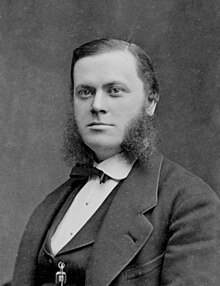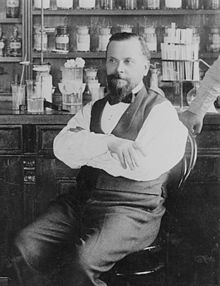Per Teodor Cleve
Per Teodor Cleve (born February 10, 1840 in Stockholm , † June 18, 1905 in Uppsala ) was a Swedish naturalist and professor.
life and work
After graduating from college in 1858, Cleve began studying mineralogy at Uppsala University . He received his doctorate there in 1863 and was appointed lecturer in chemistry and agricultural chemistry. In the years 1866/67 Cleve made a trip through England, France, Italy and Switzerland to carry out chemical and geological studies. A grant ( Letterstedtsk scholarship ) from the Royal Swedish Academy of Sciences enabled him to travel to Europe in 1867. After France and Germany, Cleve finally toured the area around the Great Lakes in North America. From New York he traveled to the Caribbean, where he examined the geological formations of the northeast Antilles . After his return to Sweden he was appointed professor of chemistry at the Teknologiska Institutet in 1870 and at Uppsala University in 1874.
In 1879 Cleve discovered the rare earths holmium and thulium . He also recognized that the didymium , which had been considered an element until then, had to be a mixture; the components were later identified as the elements neodymium and praseodymium .
Cleve was honored with the Davy Medal by the Royal Society in 1894 and the uranium-containing mineral variety Cleveit ( uraninite , which contains the rare earths Y , Er and / or Ce ) was named after him.
Works
- Om stenkol, deras uppkomst, utbredning och betydelse 1872
- Om korallerna och de kalkstensbildande organismernas betydelse i naturen 1873
- Lärobok i kemi 1872–75
- Kort lärobok i oorganisk och organisk kemi för begynnare 1874
- Qvalitativ kemisk analys 1885
- Lärobok i kemiens Grunder 1886
- Lärobok i organisk kemi 1888
literature
- Per Teodor Cleve . In: Herman Hofberg, Frithiof Heurlin, Viktor Millqvist, Olof Rubenson (eds.): Svenskt biografiskt handlexikon . 2nd Edition. tape 1 : A-K . Albert Bonniers Verlag, Stockholm 1906, p. 188 (Swedish, runeberg.org ).
Individual evidence
- ↑ MinDat: Cleveite . (English)
| personal data | |
|---|---|
| SURNAME | Cleve, Per Teodor |
| BRIEF DESCRIPTION | Swedish naturalist and professor |
| DATE OF BIRTH | February 10, 1840 |
| PLACE OF BIRTH | Stockholm |
| DATE OF DEATH | June 18, 1905 |
| Place of death | Uppsala |

